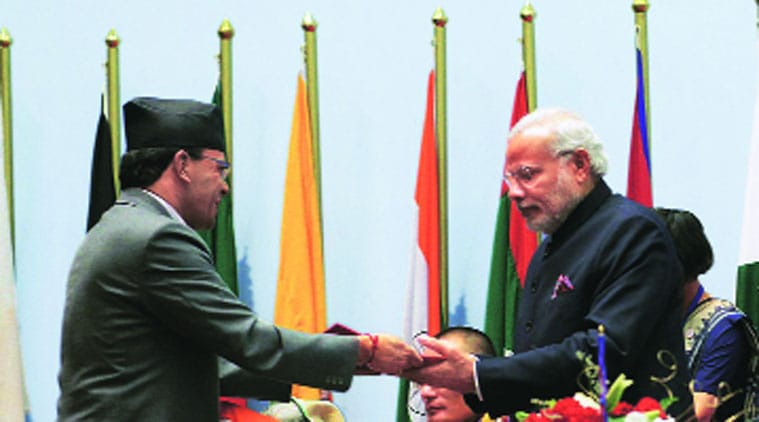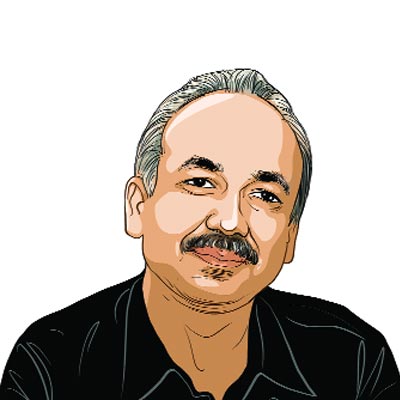Opinion Nextdoor: Nepal wants to know, India must tell
Was there an understanding with Gyanendra in 2006 to continue with the constitutional monarchy?

 It gains significance since India’s new PM has vowed to take Nepal-India relations to a new level of mutual trust.
It gains significance since India’s new PM has vowed to take Nepal-India relations to a new level of mutual trust.
Nepal has missed the deadline to deliver a constitution four times since May 2010. It is nothing new. But the difference this time is the political leadership’s inability to promptly announce the next date, without owning accountability for the failure. Unlike in the past, politics today is more polarised and the prescriptions for the future constitution are at variance with each other, even contradictory.
The Unified Communist Party of Nepal-Maoist (UCPN-M), which leads a 30-party alliance seeking ethnicity-based provinces, has finally agreed to a dialogue with the ruling coalition that itself seems in disarray now. The Communist Party of Nepal-Unified Marxist Leninist (CPN-UML) has warned Prime Minister Sushil Koirala of the Nepali Congress that it is perhaps time he owned responsibility for the January 22 deadline being missed and quit. This is likely to pave the way for a new power game, which will be more for an eighth change of government since 2006 than for creating the right conditions for constitution-writing.
However, there are more ominous trends. After a long silence, former king Gyanendra Shah asked political parties to execute the “understanding reached with me for peace, stability and prosperity”. “He is trying to have the monarchy restored because we have failed to deliver the constitution. But no agreement was reached with him for the continuation of the monarchy,” said Madhav Nepal, former PM and a senior UML leader.
But this has created ripples. Pashupati Shumsher Rana — a relative of Karan Singh, who came to Nepal as an emissary of then Indian PM Manmohan Singh in April 2006 to mediate between the king and the parties — said, “Yes, I guess there was some understanding to continue the monarchy, but Foreign Secretary Shyam Saran succeeded in changing the course two days afterwards.”
Gyanendra had handed over power, ending his 15-month direct rule, in April 2006, a day after Karan Singh met him. Forty-eight hours after the king made the declaration, Saran stated that India would support the democratic forces. His statement, read along with the provisions of the 12-point understanding mediated by India between Nepal’s Maoists and seven political parties, created the impression that India would want Nepal to be a republic. Karan Singh has not said anything on the subject, but Rana may not have spoken now without clearance. All this has come about after Manmohan Singh was succeeded by Narendra Modi. It gains significance since India’s new PM has vowed to take Nepal-India relations to a new level of mutual trust and shared prosperity.
Since 2006, Nepal’s politics seems to have revolved around a few personalities in Kathmandu and New Delhi. In a strange coincidence, Maoist leader and former PM Baburam Bhattarai rushed to India amidst prevailing uncertainties in Nepal and, through a media interview, solicited India’s “intervention”. At another interaction, Saran described Bhattarai as a “great nationalist leader” and said that India was in a “dilemma” over Nepal, which exhibited more pessimism and less hope. Coming from a key architect of India’s Nepal policy since 2005, which brought about radical changes in Nepal, it is seen as a compelling signal for the Modi government to review its Nepal policy and dispel the impression in Kathmandu that India is micromanaging its day-to-day affairs. Officially, India has asked Nepal to finish the constitution-writing process, taking into account “past agreements and the people’s mandate”.
Gyanendra’s latest message asks one pertinent question of the failed political process. The circumstances that followed his handing over of power suggest there was clearly some understanding about the continuation of constitutional monarchy. The House that met three weeks later had resolved that members of the royal family “henceforth will… be brought under the tax net” and that parliament will bring new laws for monarchical succession, making daughters eligible as well. But the euphoric parties took a short-cut to radicalism and abruptly announced the abolition of the monarchy in May 2008.
“Yes, an understanding had been reached with the king , and honouring that will bring order and create a conducive atmosphere for constitution-writing,” said Kamal Thapa, chairman of the Rastriya Prajatantra Party-Nepal. That would involve striking a balance between Nepal’s different forces. As the mediator in November 2005 and April 2006 which convinced the king that democracy and direct rule don’t go together, India still holds the key to the truth about Nepal’s politics.
yubaraj.ghimire@expressindia.com




